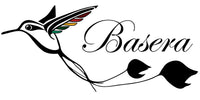Hand Block Printing in India
Hand block printing in India is a rich tapestry of history, culture, and artistry, woven together over centuries, dating back to 3000BCE. Originally introduced by Persian artists and now across the whole of India, each region specialises in it’s own unique styles and motifs, influenced by local culture, flora, fauna, and mythology.
The process of hand block printing begins with the creation of the stamps or blocks, and this is an artform in itself! These blocks are meticulously hand-carved from teak wood by skilled artisans, using only basic hand tools like a hammer and chisel, and each block can take days to create. Often a set of blocks is created for each design, one block being used for each colour in a pattern. Keep that in mind next time you see a print with five or so colours in it! Prints range from geometric to Mughal designs, but our favourite are the traditional, lush florals. Our carver, Mahboob, lives just north of Delhi and is part of a long line of block makers. His family has carved for some of the big block printing houses in India and he is in the fifth generation of carvers. We work together to create new designs whilst also using traditional designs and some of Mahboob’s own creations.
Once the blocks are ready we are off to the printers. Our printers are in Sanganer, which is the hub of Indian hand block printing. This is where we print our traditional floral and modern prints. Down the road in Bargu is where we print our Dabu prints. These are mud resist, meaning that mud is applied wherever we don’t want the dye to imprint the fabric. Fabric is dyed and then washed to remove the mud and you’re left with a dyed cloth with patches of neutral space ready to print on.
Choosing the colours for a design is a process. We often draft several options and each time colours need to be hand mixed to create the perfect shade. Where possible we love working with natural dyes made from plants, minerals, and other organic sources. Indigo, derived from the indigo plant, is used for blues; madder root for reds; turmeric for yellows; and pomegranate rind for greens. These dyes are not only eco-friendly but also lend a unique, rich hue to the fabrics that synthetic dyes cannot replicate. Where synthetic dyes are used, we opt for ASO free dyes for worker and environmental safety and a better quality product.
Once colours are finalised the real printing begins. Each colour is printed individually with its own stamp, the pattern repeating over and over again to create a full image. The colour is poured onto a pad consisting of 17 layers of different materials to create the perfect cushiness to dip the block onto. The block is dipped, aligned on the fabric and given a hard tap to evenly imprint the design onto the cotton. The average block is 20x20cm and with up to 5 blocks per fabric you can imagine how many times a block is tapped onto a bolt of fabric to create the 500m of fabric we print in each design! (it’s 62, 500!!).
Printed fabrics are washed and dried in the sun. Checked over. Cut and sent to our tailors to be turned into beautiful garments or to one of our other production groups to be turned into snuggly bedding or table linen.
We love the tradition of hand block printing, the way it involves the cotton growers, the weavers, the carvers, the colour experts, the printers, the washers and quality control team and the tailors. All this tradition and knowledge in one piece! Passed though so many sets of hands from conception to creation, each leaving its own mark and making it a truly one of a kind piece of functional art. Our goal is not only to keep these traditions alive but to enrich and uplift these artisans.
Thanks for your support!

